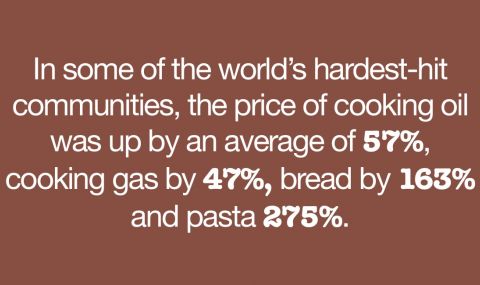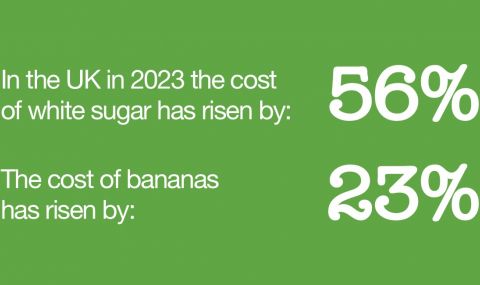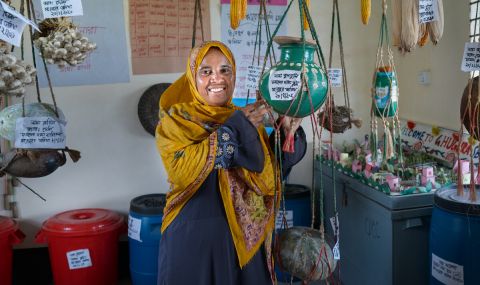Cost of living crisis: the statistics around the world
13 November 2023
Learn about the global cost of living crisis, the statistics and how it is affecting communities comparatively around the world.

Uzala (centre) and other members of a women farmers' group in Bangladesh. Photo: Fabeha Monir/ActionAid
The global economic crisis is affecting us all this winter. From our shopping baskets to our energy bills, it’s forcing prices to skyrocket and the cost of living to soar, putting heavy pressures on families everywhere.
From the UK to countries across the Middle East, Asia, Europe and Africa, millions are struggling to make end meet. Many are eating less or otherwise making sacrifices and changing their behaviour – often to prioritise buying food and essentials for those they care for.
That’s why ActionAid is working to support women around the world who are leading their communities through this crisis: taking action to find innovative solutions so they can feed their families not just today, but long into the future.
Below, we set out statistics showing the scale of the cost of living crisis, and how it’s affecting communities around the world.
Cost of living statistics from around the world
We have been facing some of the steepest price rises generations have ever witnessed before.
Recent ActionAid research has found that as this global economic crisis rages, factors such as the Covid-19 pandemic and the war in Ukraine have triggered a steep increase in global food insecurity, with prices for essentials rising by up to 900% in some communities since the start of the war in Ukraine.

Statistics show the skyrocketing price of everyday goods, particularly in some of the world's poorest countries.
Our study focused on some of the hardest-hit communities in Afghanistan, Bangladesh, Democratic Republic of Congo (DRC), Ethiopia, Haiti, Kenya, Malawi, Myanmar, Nepal, Nigeria, Sierra Leone, Somaliland, Zambia, and Zimbabwe.
Compared to February 2022, in these communities the cost of bread has risen 163%, fuel 253% and pasta 275%. Cooking oil was up by an average of 57% (rising by 224% in the district of Wajale in Somaliland), and cooking gas was up by an average of 47% (rising by 216% in the Kwara area of Nigeria).
Zimbabwe has been hit particularly hard, with people in some districts reporting truly staggering price hikes: petrol prices rising by more than 900%, sugar prices rising by more than 800%, pasta prices rising by up to 750%, prices of loaves of bread and sanitary pads, both increasing by more than 600%.
These ActionAid findings are backed by statistics across the European Union, where average food prices peaked at a high of 19.6% compared to the year.1 In 2022 more than a fifth of the EU population, some 95.3 million people, were at risk of poverty or social exclusion. The share was highest in Romania (34.4%) and Bulgaria (32.2%).2

Millions of people across EU countries have been hit hard by the cost of living crisis.
This is mirrored in the United Kingdom, where on average, prices of goods and services rose by 9.6% in the year to October 2022 – the fastest rate in four decades.3 Prices are continuing to rise – with the cost of white sugar risen on average 56%, the cost of bananas has risen 23%, and eggs 22%.4

In the UK, the cost of living crisis is causing the price of everyday goods like sugar and fruit to rise dramatically.
A recent survey showed that more than four in 10 (45%) of adults said they were buying less food when food shopping in the past two weeks in the United Kingdom5 , with people changing their behaviour, including cutting back on essentials and non-essentials, to make ends meet or save for occasions like Christmas.6
This is reflected with concerns for individuals currently paying rent or a mortgage, with almost half (47%) of adults recently reported that their rent or mortgage payments had gone up in the past 6 months. Four in 10 said they’re finding it very or somewhat difficult affording these payments.7
The wider impact of food price rises
Our research also showed that increased prices are having a disproportionate impact on women and girls. Of 1,010 total interviewees, 48% mentioned mothers reducing food intake so their children could eat, and 31% reported reduced food intake for girls.
Critically, these price rises are translating into an increased risk of extreme poverty and hunger.
It's estimated that between 691 and 783 million people in the world faced hunger last year: around 122 million more people more than in 2019, before the global pandemic.8
And it’s projected that almost 600 million people will be chronically undernourished in 2030. This is about 119 million more than in a scenario in which neither the pandemic nor the war in Ukraine had occurred, and around 23 million more than if the war in Ukraine had not happened.9
What’s causing the cost of living crisis?
As in any crisis, there isn’t just one cause or explanation for this situation.
In 2020, globally almost 3.1 billion people could not afford healthy diet, a figure which has already increased by 112 million people since 2019, thanks in large part to the Covid-19 crisis.
As the global economy began to recover from the pandemic, though, there was greater demand for oil and gas.
The war in Ukraine meant less was available from Russia, so prices rose. Meanwhile, Ukraine is historically a big producer of grain, so this has become more scarce and more expensive.
At the same time, climate change is making floods and droughts more severe and more frequent, causing shocks to global supply chains with enormous repercussions for inflation.
What ActionAid is doing to support the women leading change
Amid these overlapping crises, there are millions of women around the world who are leading their communities and building a more sustainable future.

Bulbuli, farmer and leader of a women farmers' group from Bangladesh .
Pictured above, Bulbuli, 38, is a farmer, activist and head of a local women farmers’ group in Bangladesh, which she set up with the support of ActionAid.
She says living costs are “soaring higher and higher” in Bangladesh:
Everything has doubled in price. As the price of oil has increased, everything has increased.”
But thanks to the farmers’ group, she and other local women are finding solutions. They’ve been adapting their farming methods to grow food more reliably and sustainably.
Now, Bulbuli owns a small plot of land and grows vegetables like aubergine and pumpkin – enough to feed her family and sell any surplus at the local women’s market.
ActionAid is working to support many more women like Bulbuli with small business loans, training and other projects that help them access the tools and resources they need. With this support, they are able to build more resilient, sustainable communities that are self-sufficient and future-proof.
Donate to support women and girls
Would you support more women like Bulbuli to grow a better future, without hunger? A gift from you of £20 could help provide climate-resilient seeds for five women farmers to start their own vegetable gardens, so they can feed their families and build a more secure future.
A contribution of £43 could cover the cost of training in sustainable farming for five women – training which they could then pass on to others in their community.
We’re mindful of the impact of the economic situation on our supporters and their families, and grateful for any donation you can afford, this winter. Thank you.
Footnotes
- 1https://ec.europa.eu/eurostat/en/web/products-eurostat-news/w/ddn-20230428-2
- 2https://ec.europa.eu/eurostat/web/products-eurostat-news/w/wdn-20230717-1
- 3https://www.ons.gov.uk/economy/inflationandpriceindices/articles/costofliving/latestinsights
- 4https://www.ons.gov.uk/economy/inflationandpriceindices/articles/shoppingpricescomparisontool/2023-05-03
- 5https://www.ons.gov.uk/economy/inflationandpriceindices/articles/costofliving/latestinsights
- 6https://www.theguardian.com/business/2023/oct/10/britons-eating-out-takeaways-credit-card-spending-retail
- 7https://www.ons.gov.uk/peoplepopulationandcommunity/wellbeing/bulletins/publicopinionsandsocialtrendsgreatbritain/latest
- 8https://www.fao.org/3/cc3017en/online/state-food-security-and-nutrition-2023/key-messages.html
- 9https://www.fao.org/3/cc3017en/online/state-food-security-and-nutrition-2023/key-messages.html



